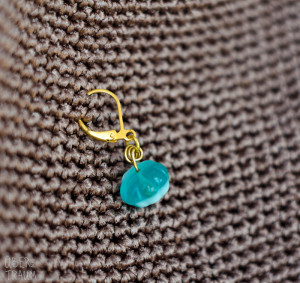Autumn has arrived, the landscapes change to beautiful rich reddish colors, temperatures decrease. This is the most loved time of the year for knitters and crocheters of the Northern hemisphere, as they dive into their yarn stashes to work once again with soft and warm fibers after a hot(or maybe too hot) summer. It is also the season they begin, or rush to finish, the Christmas projects they wish to gift away in time for the holidays.
In assistance to the influx of several and sometimes big projects, knitters and crocheters alike, trust upon a variety of craft supplies: patterns, yarn bobbins, buttons, row counters, sewing needles, gift tags, yarn swifts & winders, stitch markers and more. How much and how often these tools get used relies solely on the needs of the individual. Some swear by their cable needles, others never use them. There is a certain tool though, that is indisputably useful, no matter one’s knitting style or craft: stitch markers. There is even a meme about them!

there’s plenty more funny memes from where this one came from
I myself was a little late in discovering them, but ever since I made myself a few, I have been hooked!
There are two ‘main’ types of stitch markers: for knitting and for crochet. Although their shapes, sizes and decoration can vary greatly, the main difference between the two types is their holding loop. The knitting ones feature a closed loop, while the crochet ones feature a loop that is either open or can be opened upon request.
The reason for this differentiation is simple:
While knitting, the markers can be threaded between the working stitches on the needles and passed along like a stitch – the markers don’t fall off and follow the work that is being done.
While crocheting, on the other hand, there are no live stitches, so markers can’t be threaded between stitches. That’s why they are usually ‘hooked’ on the row just below. The stitch marker is removed and added to each row/rows that are being worked above.
This also makes crochet stitch markers slightly superior to the knitting ones, as they have one extra ability: to be moved around freely. This is very helpful in times when one forgets to place a stitch marker, and discovers that fact a little too late, or when one is misplaced. In such cases, when using the stitch markers for knitting, the knitter has to either un-knit to the point where the marker is placed and remove it or take a mental note of the mistake in order to fix it on the next row/round. In big and complicated projects, this can be very a frustrating and tedious process.
Nevertheless, no matter the type of the stitch marker, they all can do what they are made for: mark specific places in one’s work that can indicate beginning/end of round, edge stitches, increases, decreases, complex lace, change between patterns & more. They are very useful in keeping track of progress as well as in check one’s work as they go. Also many times, they eliminate the need to count stitches every few rows/rounds to keep the pattern, as would have been necessary in many projects without them.
Personally, the more I use them, the more I appreciate their practicality, especially in complex projects.
What is your experience with stitch markers? Which is your favorite type?
We would love to read your thoughts!






